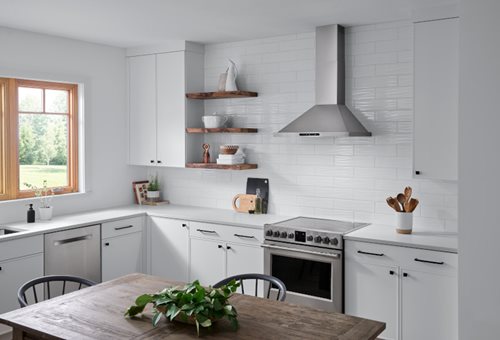Range Hood Basics Explained: What They Do, Why They Matter and How to Use Them
How many people actually use their range hood? Studies show that only about 8 percent use it consistently and only around 23 percent use it often. That is an extremely small number considering how important proper ventilation is for a healthy kitchen.Before getting into the reasons people skip using their hood, it helps to understand why there is a fan above the stove in the first place.
Why Do We Have Range Hoods?
Range hoods exist to ventilate everything released from your cooking surface. When you cook, your stovetop releases smoke, odors, steam, moisture, grease particles and gases such as nitrogen dioxide and carbon monoxide. Even basic day to day cooking produces pollutants that build up in your home.A properly used range hood removes these contaminants which improves indoor air quality, protects cabinets from grease buildup and reduces lingering smells.
Learn more about this topic here, “Range Hoods and IAQ: Why Ventilation Is Essential for a Healthier Kitchen”
Types of Range Hoods You Might Find in Your Home
Over the Range Microwave
Many homes, apartments and condos install microwaves above the stove. These units include lights and a fan, which makes them appear similar to a range hood. However, most over the range microwaves recirculate air instead of venting it outside. They also sit higher and do not cover enough of the cooktop to capture steam and fumes especially from the front burners. They typically use charcoal filters which must be functioning well to make any real difference in indoor air quality.Learn more about this comparison here, “Range Hood vs Over-the-Range Microwave: Why Proper Ventilation Matters”
Why Do People Avoid Using Their Range Hood?
Noise is the number one reason people give for not turning on their hood. A loud fan can make conversations difficult especially in open concept homes where the kitchen is connected to the dining or living area. Children doing homework nearby or family gatherings can also make noise feel inconvenient.
difficult especially in open concept homes where the kitchen is connected to the dining or living area. Children doing homework nearby or family gatherings can also make noise feel inconvenient.However, the loudest fan speeds are meant only for clearing heavy smoke or excess steam. It is better to tolerate a few minutes of noise than allow pollutants to fill your home or coat your cabinets.
If sound is a concern, pay attention to the hood’s sones rating. Sones offer a linear scale which makes them easier to understand than decibels. One sone is half as loud as two sones and two sones are half as loud as four sones. Some newer hoods list sound levels in tenths of a sone which reflects improvements in quiet performance.
Anything that moves air will create some level of sound but the benefits to your home’s air quality far outweigh a little noise.
Learn more about range hood sound levels here, “What Is a Sone? Understanding Range Hood Noise Levels and How to Reduce Them”
How to Properly Use a Range Hood
Turn on your range hood as soon as you enter the kitchen to start cooking. Setting the fan to low during meal prep helps establish airflow and creates a path for fumes once you begin heating food.When boiling water or searing food, increase the fan speed until the steam or smoke clears. After the boil slows down, you can return the fan to a lower setting.
Once you finish cooking, keep the hood running for 10 to 20 minutes. Hot food continues releasing moisture and CO2 at the table which means the hood can still be removing pollutants even after the stove is off.
Following these habits helps you keep noise low while maximizing capture efficiency.

Choosing the Proper Range Hood
When it is time to purchase a new hood or replace an old one, keep these factors in mind:
- Your Cooktop or Range Type
Your cooking surface determines the power you need. Gas ranges produce combustion fumes which require stronger ventilation. Electric and induction ranges release fewer gases but still create grease, smoke and moisture when cooking. Match the hood’s CFM level to the BTU output of your range.
Learn more about CFM and airflow here, “Range Hood CFM Guide: How to Choose the Right Power for Your Kitchen” - Range Size
Choose a hood that matches the width of your range or is slightly wider for better capture. Standard ranges are 30 inches but larger homes may have 36, 48 or even 60 inch models. - Style and Installation
Your kitchen layout determines the style that fits best. Options include:- Power pack inserts for custom cabinetry
- Island hoods for ranges located on an island
- Downdraft systems that rise from the countertop
- Chimney hoods for a modern exposed look
- Under cabinet hoods for traditional layouts
Learn more about these style options here, “Key Considerations When Choosing a Range Hood for Your Kitchen”.
For detailed style comparisons see, “Kitchen Ventilation Buying Guide 2025: How to Choose the Right Range Hood for Your Home”

 English
English
 English
English